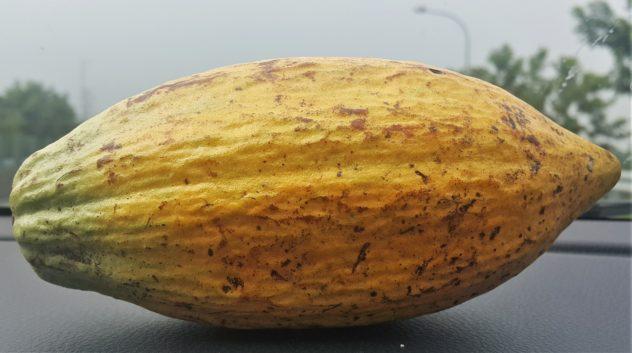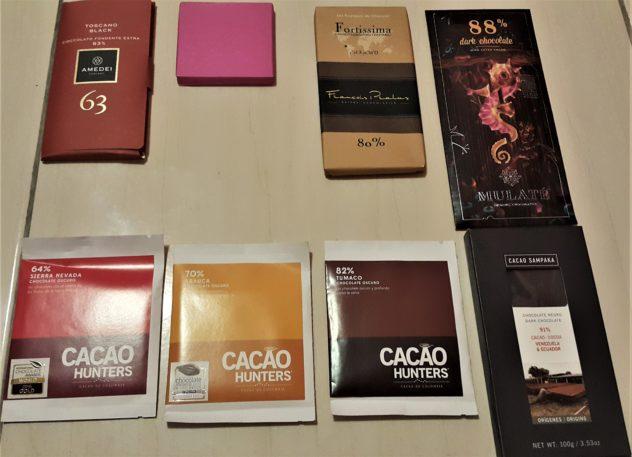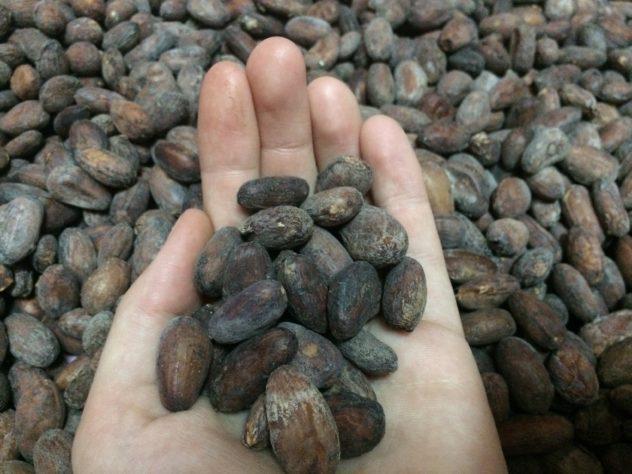Ever wanted to quit it all and go back school? Me, too. But I couldn't afford it. Plus, my passion is chocolate, and pastry school is expensive. And it's scary to give up the safety net of consistent income. However, I still wanted improve my knowledge of chocolate. So after years of deliberating, I signed up for the bean to bar chocolate making course through Ecole Chocolat, a Canadian online chocolate school catering to students from all around the world.

Jump To
Fulfilling a Need
Chocolate is a dynamic industry, always growing and changing in purpose and meaning, depending on its surroundings. But it wasn't always that way. From a revered currency during the Mayan empire and then a lofty bitter drink for 18th-century Europeans, during the 20th century chocolate became a cheap candy. Chocolate made with cheap fillers brought a love of cocoa's flavor to the masses, and it brought cacao beans to an important place in the global commodities market. Good or bad, whatever your opinion, chocolate has brought irreversible exposure to one of the most famous unknown fruits in the world: cacao.
Over the last ten years, the chocolate industry has grown from consistent sweet to craft treat. Hundreds and possibly thousands of chocolate makers have emerged around the world, making chocolate with strong connections to its ingredients. So-called bean-to-bar chocolate is crafted on a small scale, often with machinery patched together and reclaimed from a previous life. But someone needed to step up and teach some of these aspiring world-changers how to build a business that makes an impact. Enter Ecole Chocolat (French for "Chocolate School").
Founded in 2003 by Pam Williams, the school caters to aspiring chocolate makers, chocolatiers, and those who already work with chocolate. Though based in Canada, instructors and their protégé come from factories & workshops in studios & studio apartments all around the world. In my class, I (an American based in South Korea), was accompanied by students from Japan, Nigeria, Colombia, Germany, and of course North America.
Bean to bar chocolate making courses are still few and far between, but this was still a surprise to me. Many students were based outside of their native countries, with several were already dreaming up or working on tree-to-bar businesses in cacao-growing regions. Other than the quality and breadth of material, the most useful part for me was being able to access the lectures and my fellow classmates at any time of day.

About The Course
Who is It By & For?
A team of ten instructors and employees from various backgrounds, including Pam Williams herself, dedicate their time to keeping the school on track. Most of these educators also have their own businesses in chocolate, but I found the communication with my instructors and fellow students to be consistent, even through the fierce hurricanes this fall.
After completing the course in chocolate making, I believe that this is a school for students who want to gain a very thorough understanding of the cacao and chocolate industry in a much shorter period than it would normally take. This course in particular is for those interested in learning how to develop or improve their skills in chocolate making from bean-to-bar. In the five years I had previously been working with chocolate as a hobbyist, I had learned maybe half of this general information and a smattering of the specific facts.
But don't be fooled. This won't turn you into a chocolate expert in just two months. However it can give you a solid basis from which to start a chocolate business, as long as you put in the work. If you feel prepared to continually use their library and other resources to carry on your studies, this is a good option for you. Enough articles are provided for you to focus on cacao production & sourcing, or on chocolate making & tasting, if you so choose. You can take advantage of these free networking opportunities with chocolate people around the world, and learn from each other, even after the course ends.

What is It?
Basically, the 2-month 100% online chocolate-making course teaches students how to craft chocolate at home, or in a professional kitchen, through case studies & practical homework. Additionally, there are tasting assignments in which you compare finished chocolates and learn how to properly source ingredients. Don't be fooled by the online platform; this is an accrediting program with expectations and standards. Upon logging in for the first time, my initial impression was "wow, I feel like I'm back at university." The interface is quite similar to what my school used back then, and regrettably just as vaguely annoying to navigate.
The pre-course information is quite basic, so even if you begin the course late, it's easy to catch up. But once you start, all bets are off. The overall flavor of the program is that of crafting sustainability throughout the chocolate industry. There are not many chocolate courses out there of any kind, unless you count those for pastry chefs. But this class will provide you with all the tools to begin building your place in the rapidly-expanding fine chocolate industry.
Where is It?
The course is conducted 100% online, so it is located wherever you find an internet connection, though the founders are based in Canada.
How Do You Learn?
Students engage with the curriculum through assignments, open communication with the instructors, forums with fellow students, and deep dives into chocolate research. The course is divided into six sections, with 4 assignments and 6 exercises due over the course of two months. The modules are: Welcome, Understanding The Chocolate Industry, Understanding Chocolate Flavor, Sourcing Cocoa Beans, The Chocolate Manufacturing Process, and Formulating Your Operations Plan. There are 3 optional exercises for those who are already making chocolate from the bean.
In two months of doing my readings and diligently following the provided material, I learned much more about cacao production and sourcing than I did in my seven months of hands-on study in Latin America. The direction and further reading provided by the course material, and the ability to network with and crowd source information from a like-minded group of chocolate heads is invaluable.

When is It?
The exact course I took went from Sept. 15-Nov. 17, 2017. After graduation, you retain access to the school's online library and graduate center. The 2-month chocolate making program is offered every March and September, with limited spots available. Something to consider is that even though they say you will spend about 8 hours a week on the course, in my opinion a more realistic assessment is 15 hours. To thoroughly read the material and take notes, plus complete your weekly homework is a pretty sizable commitment, and this is someone with half a decade of steeping in the chocolate world. You will need even more time if English isn't your first language.
Why Should I Do It?
This course is not for everyone. As much cacao as there is, the chocolate business will reach a limit, one day far in the future, but that day has not yet come. You should undertake this course if you are interested in starting a business which focuses on chocolate, or if you would like to start becoming a chocolate expert. This course's mission is to teach students about bean-to-bar chocolate making, but you take as much out of it as you choose to. I took this course to improve my skills as a chocolate maker, and to learn more thoroughly and accurately about the industry. Ideal students are passionate about chocolate, and dedicated to spending a couple of hours daily on chocolate education, throughout the course.
Practical Information
Potential Struggles
- Time management is difficult in the beginning. The number and length of readings can be overwhelming at first, but you NEED to spend a couple of hours a days at minimum for reading and taking notes and watching the videos. Between working on this site constantly and holding down a full-time job, my only complaint is that I really didn't have quite enough time for thorough examination of the materials during the course. I'm in luck, however, as my access to their library of resources is a forever sort of deal once the course is over.
- Structure of Assignments is not set in stone, which can be difficult for people who are used to set parameters. Your tasting assignments and modules need only to answer the questions, not fit into tiny boxes. It's not like university, where one too many failing grades gets you kicked out; instructors work with you to clarify materials. You do receive a grade out of 100, but this is more to determine whether or not you graduate "with honors." All the same, I wish they had provided a few examples of how past students formatted reviews, or pointed towards professional-level reviews.
- Choosing to read only the articles relevant to me. They provide, as I have said, dozens of hours of materials per week. You need to decide what your own emphasis in chocolate is, and focus on those materials. Some people only want to make chocolate at home, others will open a business, and some are only there to become better chocolate consumers. Choose your own path.
- Finding materials for each and every region of cacao beans was sometimes left to students. Latin American countries were generally well-covered, but with all of the new cooperatives popping up at origin these days, I expected more thorough coverage. Many of the sourcing articles were over a decade old, and quite frankly, redundant and unhelpful. However, I was able to add some materials to their meager list for a few of the countries, and request that fresh articles be researched and added for future students. I feel confident that this will be done.
- Obtaining the chocolate bars & cacao beans was a struggle for me, being based in rural South Korea.

Potential Saviors
- I cannot emphasize enough the breadth of information offered in this course. But it's both a blessing and a curse. The readings are actually only released two weeks before the assignments are due, likely because the sheer volume of it all would overwhelm students if they saw it all from the start.
- Dozens of case studies of successful chocolate makers offer a variety of paths and perspectives on chocolate, from the start of the course.
- There are three different forums for asking questions of or chatting with your classmates. Some cohorts will be chattier than others, and unfortunately mine was rather quiet. But still, I've come out with several contacts in the chocolate industry around the world, including my instructors.
- Pam is supportive in allowing students to give feedback & improve the course from their many varied new perspectives. At the end of the course, she asked that we all fill out evaluations in order to improve the course for future cohorts.
Price of the Course
$455USD/$455CAD for Canadians (+$145 if you do the optional 1-month business module).
Materials Required
~22 fine chocolate bars from a variety of makers ($100-200, though if you cannot source this many fine chocolate bars, the instructors will work with you) & a computer with internet access.
The course introduces you to chocolate. But it also tells the stories of dozens of chocolate makers, mostly from North America and Europe, some of which may even be idols of yours. One of our articles was an interview with a well-known chocolate maker asking them about how they got into chocolate. Most people have one experience with a certain chocolate bar that really changes their perception of what chocolate is and can be. Mine was at the Chocolate Garage, half a decade ago.
So what has been your change of perception? Has it happened yet?
Note: this was my personal experience, which I spent my own money on. The school has not compensated me in any way for this review. I wasn't sure what to expect when I signed up, so I figured others will find themselves in the same boat.

















Dee
I had a less than stellar experience with this business. I cannot recommend this school. I saved up for a while to be able to afford this course.
Full disclaimer, I did not understand what I was buying. Most programs you purchase these days are for lifetime access. I did not realize this $1000 class was for a limited time. I own my mistake. However, around the same time that I purchased this class, my son borrowed my laptop for school and ended up losing it so I had no access to get into this course. As time went by I forgot I purchased this class. Fast forward a year later I found my laptop and tried to log in only to find out that the class was over and I missed out, totally my fault. But when I reached out to explain the situation I was reprimanded with "you should have reached out sooner" and "we can give you 10% off your next purchase". For me, this is an epic fail in customer service. There is no economic hardship for this company to extend my access. It would literally cost them $O to have extended my access for a short while to allow me to review the material. Wish I would have had the opportunity to learn and did not waste my money. I've learned that I should have read the fine print a little better.
Max
I'm so sorry you had such a negative experience, Dee - it's definitely not cheap, and I agree that it's frustrating and not made clear why access is so limited. I hope that you won't give up on learning more about chocolate, however, as there are a number of really great resources out there. If you're not sure where to start with chocolate making or chocolatier-ing, Chocolate Alchemy is a great free resource, and incredibly searchhable. I know it doesn't take the sting away, but I hope it helps you on your chocolate journey.~
Ella Bellinghiri-Foster
Excellent piece, thank you! Are you crafting chocolate now as a full-time vocation?
Max
Thank you! And no, I write about chocolate & cacao full time. 🙂
Chaza Alzahrawi
Thank you, this a a very helpful review.
Max
I'm so glad to have helped, Chaza!
Emiley Stevens
This article is just what I was looking for! I have been debating taking this course for a few years now but as I have just opened up my own little chocolate company I feel compelled to take it and learn more. I also live in WA! Thanks!!
Max
You're very welcome, Emiley! I'm glad I was able to help you weigh your options and decide whether or not the course is right for you. I hope you enjoy it as much as I did!
Nita E
This very helpful. Thank you for sharing your experience.
Max
You're very welcome! I'm glad you found it helpful. 🙂